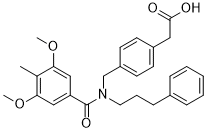ONO-7300243
This product is for research use only, not for human use. We do not sell to patients.

For small sizes, please check our retail website as below: www.invivochem.com
| Size | Price | Stock |
|---|---|---|
| 250mg | $1250 | Check With Us |
| 500mg | $1950 | Check With Us |
| 1g | $2925 | Check With Us |
Cat #: V2583 CAS #: 638132-34-0 Purity ≥ 98%
Description: ONO-7300243 (ONO 7300243, ONO7300243) is a novel, potent and selective antagonist of LPA1(Lysophosphatidic Acid Receptor) with an IC50 of 160 nM.
Top Publications Citing Invivochem Products
Publications Citing InvivoChem Products
Product Promise

- Physicochemical and Storage Information
- Protocol
- Related Biological Data
- Stock Solution Preparation
- Quality Control Documentation
| Molecular Weight (MW) | 461.55 |
|---|---|
| Molecular Formula | C28H31NO5 |
| CAS No. | 638132-34-0 |
| Storage | -20℃ for 3 years in powder formrr |
| -80℃ for 2 years in solvent | |
| Solubility In Vitro | DMSO: 92 mg/mL (199.3 mM)rr |
| Water: <1 mg/mLrr | |
| Ethanol: 92 mg/mL (199.3 mM) | |
| SMILES Code | O=C(O)CC1=CC=C(CN(C(C2=CC(OC)=C(C)C(OC)=C2)=O)CCCC3=CC=CC=C3)C=C1 |
| Synonyms | ONO 7300243, ONO7300243; ONO-7300243 |
| Protocol | In Vitro | ONO-7300243 shows modest in vitro activity (IC50=0.16 μM). ONO-7300243 exhibits almost identical levels of antagonist activity in vitro |
|---|---|---|
| In Vivo | ONO-7300243 shows good efficacy in vivo. The oral dosing of 17a at 30 mg/kg leads to reduced intraurethral pressure in rats. ONO-7300243 shows stronge effects in vivo (88% inhibition at 10 mg/kg i.d., 62% inhibition at 3 mg/kg i.d.) compared with compound 12g. The results reveal that ONO-7300243 shows good membrane permeability and good metabolic stability against rat liver microsomes (MS). ONO-7300243 exhibits good selectivity towards LPAl over LPA2, most likely because low molecular weight and low lipophilicity lead to reduced compound promiscuity and increased selectivity. ONO-7300243 inhibits the LPA-induced IUP increase in a dose dependent manner (ID50=11.6 mg/kg p.o.) up to 1 h after dosing. Significant effects are observed at 10 and 30 mg/kg (p<0.05 vs.vehicle). ONO-7300243 (30 mg/kg, p.o.) leads to a significant decrease in the IUP in conscious rats without LPA stimulation compared with the vehicle without affecting the mean blood pressure (MBP). The results of a rat pharmacokinetic study of ONO-7300243 show that this material had a rapid clearance (CLtot=15.9 mL/min/kg at 3 mg/kg i.v.) and a short half-life (0.3 h) |
These protocols are for reference only. InvivoChem does not
independently validate these methods.
| Solvent volume to be added | Mass (the weight of a compound) | |||
|---|---|---|---|---|
| Mother liquor concentration | 1mg | 5mg | 10mg | 20mg |
| 1mM | 2.1666 mL | 10.8331 mL | 21.6661 mL | 43.3323 mL |
| 5mM | 0.4333 mL | 2.1666 mL | 4.3332 mL | 8.6665 mL |
| 10mM | 0.2167 mL | 1.0833 mL | 2.1666 mL | 4.3332 mL |
| 20mM | 0.1083 mL | 0.5417 mL | 1.0833 mL | 2.1666 mL |
The molarity calculator equation
Mass(g) = Concentration(mol/L) × Volume(L) × Molecular Weight(g/mol)
Mass
=
Concentration
×
Volume
×
Molecular Weight*
The dilution calculator equation
Concentration(start)
×
Volume(start)
=
Concentration(final)
×
Volume(final)
This equation is commonly abbreviated as: C1 V1 = C2 V2
Concentration(start)
C1
×
Volume(start)
V1
=
Concentration(final)
C2
×
Volume(final)
V2
Step One: Enter information below
Dosage mg/kg
Average weight of animals g
Dosing volume per animal µL
Number of animals
Step Two: Enter the in vivo formulation
%DMSO
+
%
+
%Tween 80
+
%ddH2O
Calculation Results:
Working concentration:
mg/ml;
Method for preparing DMSO master liquid:
mg
drug pre-dissolved in
µL
DMSO(Master liquid concentration
mg/mL)
,Please contact us first if the concentration exceeds the DMSO solubility of the batch of drug.
Method for preparing in vivo formulation:
Take
µL
DMSO master liquid, next add
µL
PEG300, mix and clarify, next add
µL
Tween 80,mix and clarify, next add
µL
ddH2O,mix and clarify.
Note:
- (1) Please be sure that the solution is clear before the addition of next solvent. Dissolution methods like vortex, ultrasound or warming and heat may be used to aid dissolving.
- (2) Be sure to add the solvent(s) in order.




































